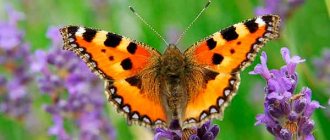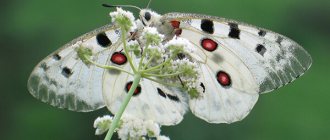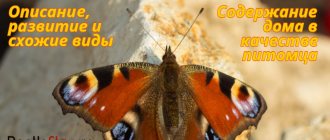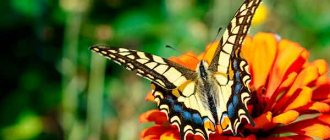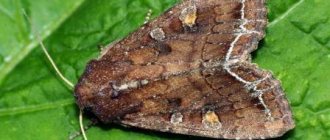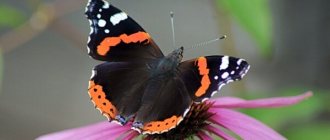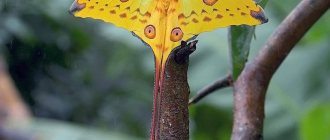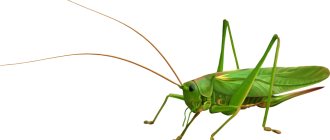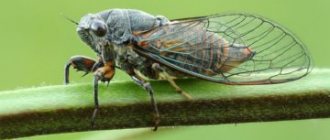- Wild animals
- >>
- Insects
The blueberry family is very extensive, it includes more than 5,000 species of butterflies, sometimes very different from each other and living in different climatic conditions - from the equator to the Arctic Circle. The blueberry butterfly has very beautiful wings; their relationship with ants is also of interest.
Origin of the species and description
Photo: Blue butterfly
The evolution of Lepidoptera is closely connected with the evolution and spread of flowering plants across the planet: as the latter became more and more numerous and more developed, the species diversity of butterflies grew, they acquired mouthparts adapted for nectar production and beautiful wings.
The modern blueberry in all its diversity of species appeared in the Neogene. The scientific description of the blueberry family was made in 1815 by W. Leach, the original name in Latin was Cupidinidae, then changed to Lycaenidae.
The family is very large, so only a few species can be briefly described:
- Blueberry (Polyommatus icarus, described by S. Rottemburg in 1775) is the most typical species for Russia. It has a wingspan of only about 15 mm. In males they have a soft blue tint, in females they are brownish-blue;
- Long-tailed blueberry – Lampides boeticus (Linnaeus, 1767), is notable as the only representative of the genus. It also has a small wingspan and is interesting for its tendency to migrate over long distances - it does not form permanent populations;
- evenus coronata, a species described by Hewitson in 1865, is a tropical butterfly native to Central America. It is notable for its largest wingspan of 60 mm in the entire family, as well as for its beauty: they are a very rich, almost luminous azure color with a black border.
Interesting fact: The writer Vladimir Nabokov was also an entomologist and in his travels across America he discovered a large number of species of insects, including the scientific descriptions of several species of bluebirds.
Notes
- ↑ Lvovsky A.L., Morgun D.V.
Keys to the flora and fauna of Russia. Issue 8 // Lepidoptera of Eastern Europe. - M.: Partnership of Scientific Publications KMK, 2007. - 443 p. — 2000 copies. — ISBN 978-5-87317-362-4. - ↑ Plyushch I. G., Morgun D. V., Dovgailo K. E., Rubin N. I., Solodovnikov I. A.
Day butterflies (Hesperioidea and Papilionoidea, Lepidoptera) of Eastern Europe. CD identifier, database and Lysandra software package. - Minsk, Kyiv, Moscow, 2005. - Plavilshchikov N.N. Identifier of insects. A brief guide to the most common insects in the European part of the USSR. M.: Uchpedgiz 1957
- Gorbatovsky V. Insects of Russia. Beetles, butterflies and others. M.: AST, 2014
- Sochivko A.V., Kaabak L.V.
Key to butterflies of Russia. Daytime butterflies. - M.: Avanta+, 2012. - 320 p. — 5000 copies. — ISBN 978-5-98986-669-4. - ↑ Shalygina L.
. Website of the television and radio company Yleisradio Oy. Yle News Service (15 June 2017). Retrieved June 17, 2022. - Lafranchis T. 2004. Premiere contribution a la connaissance des plantes-hotes naturelles des Rhopaloceres et Hesperides de Grece (Lepidoptera) // Linneana Belgica, Pars XIX, No. 5. P. 241-250
- Harvey, DJ; Webb, Ta, 1980: Ants associated with Harkenclenus titus, Glaucopsyche lygdamas, and Celastrina argiolus (Lycaenidae). Journal of the Lepidopterists' Society 34: 371–372
- Fiedler K., 1989: European and north west African lycaenidae lepidoptera and their associations with ants. Journal of Research on the Lepidoptera 28(4): 239–257
Appearance and features
Photo: Blueberry butterfly from the Red Book
The dimensions are small: the wingspan usually ranges from 20 to 40 mm. In rare cases, it can reach 60; this is typical for tropical butterflies; smaller species live in the temperate zone. The wings are wide, allowing you to glide. Some pigeons have “tails” at their ends, but for the most part they are rounded, and when folded they are close to a triangular shape, but smoothed. The color of the wings is blue, from pale to bright, heavenly color. There are splashes of black and white, as well as yellow spots.
The wings can also be brown or fiery in color. Males have a much brighter color than females, since it falls to them to attract a partner, and the female only makes a choice in favor of one of the males. In addition, the female's wings usually have less pronounced spots or no spots at all.
Video: Blueberry Butterfly
In addition to these colors, there are others, because there are a lot of blueberries, and they are all different: there are whitish-yellow, white with black specks, gray with blue, and so on. The name of this butterfly comes from the widespread blueberry Icarus.
The lower part of the wings of bluebirds is painted in a protective color - usually gray or brown, which allows them to camouflage themselves on tree trunks and in bushes. They have club-shaped antennae and short palps. Males also differ in that their front legs are poorly developed; they move on the middle and hind legs, but in females all three pairs are equally developed.
Now you know what a blueberry butterfly looks like. Let's now see where she lives.
A small miracle of the middle zone
Contrary to their name, not all blueberries are sky-colored. Among them there are golden, purple, gray, brown, red.
Many have the underside of their wings edged with a series of bright eyes. Their body is noticeably fluffy, the thinnest antennae are often striped, like a police baton. The edges of the wings are fringed - for this feature the British call butterflies “veil-winged”.
It is believed that the fringe helps dampen air turbulence that occurs during flight.
This is very important for the smallest butterflies, because otherwise they will not be able to overcome the resistance of even a weak wind
Blueberries are found in abundance in water meadows. They extract sweet nectar from clover inflorescences, and the microelements necessary for full reproduction from liquid mud. In search of mineral salts, they often land on compost heaps, manure and even human skin, especially if it is sweaty.
Where does the blueberry butterfly live?
Photo: Blue butterfly Icarus
This butterfly really loves warm, tropical weather - a significant part of its species is found only in the tropics, less in the subtropics, and hardly one in ten is found in the temperate zone. But these species, for example, the Blueberry Icarus, are able to tolerate significant temperature changes and live in fairly cold areas.
The range is very wide and includes all parts of the world. You won't find bluebirds except in the Arctic and Antarctic. Although relatively few species live in temperate regions, their populations are quite large, and they are especially common in Central and Eastern Europe.
They prefer open, sunny areas with few trees or shrubs for living. These are meadows, gardens, clearings, forest edges, banks of rivers and lakes. Blueberry Icarus is very fond of alfalfa fields and is found there in large quantities.
Less common, but also found, are bluebirds right in populated areas, where they can live in parks or gardens. The largest number of these butterflies live in flat areas; with increasing altitude, the diversity of species and frequency of butterflies decreases, but up to 1,500 meters there are quite a lot of them, some are also found at altitudes up to 3,300 meters.
They usually do not move long distances - they can fly to a more attractive area, but usually located within a few hundred meters. Subsequently, they spend their entire short life on it or nearby.
Classification
416 genera and about 5,200 species (as of December 2011), including one fossil species. In some classifications, this also includes the Riodininae group (for example, Abisara echerius)[8].
Riodininae (eg Abisara echerius)
Among the bluebirds there are taxa described by the writer Nabokov: Cyclargus Nabokov, 1945; Echinargus Nabokov, 1945; Cyclargus erembis Nabokov, 1948 (now considered as a subspecies of Cyclargus ammon erembis) and others.
The family has the following subfamilies:
- Curetinae - Oriental region, Palaearctic
- Liphyrinae - Africa, Asia
- Lipteninae - Afrotropics
- Chervontsy (Lycaeninae Leach.1815) – Holarctic
- Tribe Lycaenini
- Tribe Heliophorini
- Miletinae - Africa, Oriental region, Holarctic
- Polyommatinae Swainson, 1827 - Everywhere
- Poritiinae - Oriental region
- Tailworts (Theclinae Swainson, 1831) - Ubiquitous (about 20 tribes and 200 genera)
What does the blueberry butterfly eat?
Photo: Blue butterfly
Caterpillars can attack a variety of plants, depending on the species. Thus, the tailed caterpillar prefers the leaves of trees and shrubs, and the many-eyed caterpillar prefers buckwheat and legumes. Some can harm garden trees or shrubs.
It is interesting that not all blueberry caterpillars eat only plants - some can diversify their menu with living creatures, or even feed only on them.
Among their victims are:
- aphid;
- mealybug;
- ant larvae;
- other small insects;
- other caterpillars, including those of the same species.
Yes, this is a rare example of predator caterpillars, and sometimes they engage in cannibalism - they are very different from the larvae of many other butterflies, which are harmless and eat only leaves!
Many of them nest well in anthills, forcing the ants to feed themselves - they do this because of the liquid that their nectar-bearing gland produces. Some also have organs that produce sounds, which the ants obey.
In their adult form, blueberries feed primarily on nectar, and in this regard they are not at all picky: they like clover most of all, but almost any flower suits them. Moreover, they are also able to feed on the sap of trees and rotting fruits, secretions of aphids and even bird droppings.
There are many species of blueberry, and some of them can even feed on foods that are extremely interesting for butterflies: for example, some are attracted to canned food and lard.
Life cycle
Wintering takes place on woody plant stems. Light green caterpillars with black stripes on their backs with a light frame emerge from the eggs. Insects are unpretentious when it comes to food; they choose buds of young plants and heather buds. In the Moscow region they can be seen on peas and clover. They are active in the evenings and at night - the caterpillar feels safer in the dark than in the daytime. During the day it hides in the foliage.
Caterpillar
Insects move to anthills, where they feed on larvae and pupate. It is surprising that ants of the genus Formica warmly welcome uninvited guests into their homes - they are attracted by the characteristic sweetish liquid secreted by the glands of the Argus blueberry.
Butterflies appear in early June and live until August. Bluebirds fly close to the ground and move short distances. They often rest on leaves and stems.
Male
Features of character and lifestyle
Photo: Blueberry butterfly from the Red Book
They love the sun and warmth, and are active only during the day, and when it ends, they look for a secluded place to spend the night in. In adult form they do not live long, from 3-4 days to 3 weeks, depending on the species. That is why, although their population is quite large, they are much less common than urticaria.
Most often, development occurs in two or three generations, but in warm areas there can even be four. As a result, you can find the blueberry not only throughout the summer, but also during most of the spring and autumn. Blueberry caterpillars and sometimes pupae overwinter: they can do this not on the stem of a plant or in warm litter, or right on the ground, in a mulberry network.
Some blueberries overwinter in anthills, or ants hide them in shelters in the ground, for example, in cracks. The caterpillars are notable for the fact that they live alone and secretly; they are difficult to notice on plants due to their color matching the leaves - they are not only the same shade of green, but even reproduce veins.
Many bluebirds are closely related to ants - they have relationships with them ranging from symbiotic to parasitic - depending on the type of butterfly. This is also why they are remarkable, because in many other butterflies, for example, urticaria or lemongrass, the caterpillars suffer from ants, but the blueberry is not in danger from them - and on the contrary, it itself is dangerous for them.
Icarus
This daytime butterfly is a typical representative of the blueberry family. Depending on the habitat, it can develop in two or three generations. And in the steppes of Ukraine and in the south of Crimea, a fourth one is possible.
Quite often, females lay eggs next to anthills on newly emerging leaves. Later, young caterpillars move to the lower part of the leaf and first eat its edges, and then destroy the entire surface completely. Usually either a caterpillar or a pupa overwinters, which happens much less frequently.
The blue butterfly Icarus got its name from the Greek mythological hero Icarus, the son of Daedalus. He took off on wings made of feathers and held together with wax, flew too close to the sun, the wax melted and Icarus died. The blue butterfly, the photo of which you see in our article, is widespread in Russia, in its central zone. It can be seen from April to October. During the year, from one to four generations develop. It depends on the latitude of the habitat. Caterpillars feed on leaves, buds, and flowers of a wide variety of plants, most often legumes.
These are small butterflies, their front wing does not exceed seventeen millimeters. The wings of the male are painted in a rich blue-violet color, while the females are brown with yellow spots. Icarus is characterized by an ocellated pattern on the underside of its wings. It consists of two rows of black spots along the edge, which are usually separated by an orange stripe. It can be flat or curved.
Blueberry Icarus is a good pollinator of wild and cultivated legumes.
Blueberries are daytime butterflies. There are about 5,200 species in this family. Blueberries live mostly in the tropics; only about 500 species live in the temperate zone.
Social structure and reproduction
Photo: Blueberry butterflies
Bluebirds live alone and are prone to territoriality: usually adults live in one place all their lives and tend to defend it: they can attack other bluebirds or bees and other insects, trying to drive them away. During the breeding season, males try to attract a female, but at other times they can even show aggression towards her.
As a fully metamorphosed insect, the blueberry goes through four standard stages. Their duration and characteristics can vary greatly from species to species; below we will briefly consider how reproduction and development to adults occurs in the spring blueberry.
Butterflies of the first generation lay eggs in early summer, the second in mid-August. There are usually 50-80 eggs, they are laid one per leaf or fruit bud by females of the first generation, and on the ovary of fruits by females of the second generation. The egg develops, depending on weather conditions, from 3 to 7 days - on cold days it takes longer.
Then the caterpillar appears, they can feed on a large number of plants, and not only leaves, but also flowers, buds, fruits - they are even preferable because they are more nutritious. Thus, caterpillars of this species can become a garden pest if they end up on currants, apple trees, and pears.
They can come into contact with ants, but they do not always do this - researchers suggest that the spring blueberry caterpillar does this only when there is a lack of nutrients or after experiencing a threat from a predator. After two to three weeks of intensive feeding, the caterpillar pupates, and after another week the butterfly breaks through the cocoon.
The situation is different with the second, or, in warm areas, the third generation per year: by the time the caterpillar grows to a sufficient size, it becomes colder, and therefore it goes into hibernation, choosing a warm place. Sometimes it pre-pupates and often hibernates in an anthill.
Caterpillars of bluebirds associated with ants live near anthills, and the pupae lie right in them. They can also be attached to branches or leaves of trees, or lie directly on the ground. After the appearance of the caterpillars, their lifestyle depends on what species they belong to: they spend all their time on plants, feeding on leaves and being exposed to dangers, until they turn into pupa.
Others fared much better: for example, the Alcon blueberry lays eggs in a gentian flower. They spend the first time inside the flower, feeding on its pulp, protected from the attacks of predators, until they gnaw a hole in it and get out. This takes a couple of weeks. Then they go down and wait for the ants to find them.
Thanks to the substances they produce, they don’t spend long waiting: they quickly find them and take them to the anthill. They continue to grow there in complete safety, then pupate there. In a similar way, many bluegills protected themselves from the dangers of existing in the form of a caterpillar.
Biology
In the predominant part of its range in Eastern Europe, two generations develop per year. Butterflies of the second generation are distinguished by their larger sizes and wider darkening of the outer part of the wings of females.
The flight time of the first generation butterflies occurs from late April to early June, the second generation - from early July to mid-August. Butterflies primarily fly high in the treetops and come down only to feed on flowers. Females lay up to 85 eggs individually on fruit buds and young leaves, and females of the second generation lay eggs on setting fruits. The egg stage lasts 3-7 days. In addition to leaves, caterpillars can feed on buds, flowers and ripening fruits, gnawing furrows and pits on their surface. Caterpillars are polyphagous. Forage plants: astragalus, common heather, meadowsweet, brittle buckthorn, buckthorn, gorse, common ivy, laxative jester, black currant, red currant, raspberry, Rubus sp.
,
Vicia sp.
, pink (including apple, pear, thorn).
In Greece, the development of caterpillars was also observed on the tree-tree ( Paliurus spina-christi
).
Caterpillars are myrmecophiles. Contacts with many species of ants: Lasius niger, Lasius alienus, Lasius fuliginosus, Camponotus japonicus, Camponotus nearcticus, Formica subsericea, Formica truncorum, Myrmica sp.
.
Natural enemies of blueberry butterflies
Photo: Blueberry butterfly on a flower
There are many of them at all stages of development.
Mainly these are:
- birds;
- rodents;
- lizards;
- toads;
- spiders.
Danger threatens bluegills throughout their lives, starting from the egg stage - adult butterflies, which are able to fly away from most predators, are least exposed to it. But not from everyone: their main enemy is birds, which are much faster, they are able to catch butterflies right in the air, or lie in wait when they are resting.
Insects can also hunt butterflies: dragonflies do this right in flight, spiders set nets on them, and praying mantises guard flowers. But the threat is still especially great for caterpillars: they are not able to escape from a predator, and the same birds are much more willing to attack them, because the butterflies still need to be caught, and one at a time. There are usually a lot of caterpillars close to each other, and you can devour dozens at once. Caterpillars are especially often used as food for voracious chicks.
Therefore, many blueberry caterpillars have defense mechanisms, due to which a relatively large number of them survive: for example, placing eggs on the ovary of a flower, so that the caterpillar is then reliably hidden from predators most of the time. Or interaction with ants, allowing you to overwinter or develop in an anthill without danger.
People spoil the lives of bluegills much more: due to the deterioration of the environment and the disappearance of their habitats, the population of some species has greatly decreased, and they are in danger of extinction - predators were not able to bring it to this point.
Interesting facts from the world of Lepidoptera
All species of Lepidoptera have a very original structure. They do not have lungs, so they never sleep, even if they are only nocturnal or diurnal. These winged insects reach speeds of up to 50 km/h and pretend to be dead to escape from birds or mammals that eat lepidoptera.
The vision of Lepidoptera is designed in such a way that they distinguish colors:
- red;
- yellow;
- green.
Of all insect species, they are the most warlike. They constantly fight with each other for warm and sunny territories.
Medicine uses large species of proboscis Lepidoptera for therapeutic purposes. With their help, mental disorders, depression and post-traumatic conditions are treated in special greenhouses.
Population and species status
Photo: Blue butterfly
Thanks to all the features described earlier and the tricks that emerged during evolution, populations of bluegills are incredibly tenacious: they reproduce quickly, because in comparison with most other butterflies, a much larger percentage of larvae survive to adulthood.
It says a lot that out of all the variety of blueberry species - and there are about 5,200 of them, only one is known to be completely extinct. That is, most of the bluebirds are not threatened, even in modern conditions, when many previously widespread species of butterflies are becoming quite rare, or even on the verge of extinction.
But this does not apply to everyone, because there are a lot of different blueberries, not all species have a wide range and large population, and therefore some of them may be endangered, others are already listed in the Red Book - most often only in certain countries.
Interesting fact: The pupae of some species of blueberry have funny defenses against predators - for example, the pupa of the plum tail looks like bird droppings - few people will want to dig into it! In the blue chervonets, it disguises itself as a poisonous ladybug pupa, to which predators usually do not react. And if you touch the oak tail pupa, it will begin to creak.
